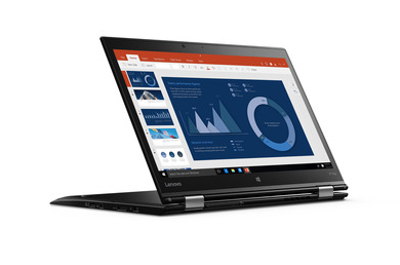Lenovo announced a new laptop-tablet hybrid family - the X1 Yoga, which is the world's first OLED laptop. The X1 Yoga is equipped with a 14" 2550x1440 display - LCD in the lower models and OLED in the higher-end ones. The hybrid configuration goes up to Core i7 CPUs, 16GB of RAM, 1TB of SSD storage. The laptop weighs 1.27 Kg.

The basic X1 Yoga starts at $1,449 (with an LCD) - the OLED model will be released in April 2016 - price hasn't been announced yet.
The 14" AMOLED is produced by Samsung Display. In October 2014 it was reported that Samsung Display developed a 14" OLED panel aimed for laptops - and it's great to see that this was correct - and we finally have the world's first OLED laptop! A while back ago we posted an article about OLED monitors and laptop displays in which I discussed why there isn't any such product on the market yet.
According to reports LG Display also aims to start producing OLED panels for computer monitors and laptops, with the first displays to begin shipping in 2016 or 2017.
Comments
It’s hard to hear something distinctly in the video (from YouTube comments: “He’s trying hard to be unheard in the video”). For example, I’ve heard something like that OLED version will cost 2000 more than the LCD one, but I’m not sure. %)
Anyway, if both (LCD- and OLED-powered) versions of the same model will be shown on CES 2016, it’s probable that the OLED one is just a prototype intended to test the consumer interest (like “See how our laptop would look like if was equipped with an OLED display; would you buy it if it was available?”) while the LCD one is probably currently planned to be the only available commercially.
But if the OLED version is actually going to hit the market, that’s really great. Though the resolution of 2560×1440 is currently somewhat small (I have 2560×1600 on my 10.5-inch tablet, and I can see the pixels), it would be a good beginning anyway.
The OLED is 200$ more than the IPS version with same specs.
And pixel density is not about if you can see the pixels or not. Its just about a higher quality experience in general, for everything. We are FAR away from truly losing sight of pixels.
16:9 is really a travesty for laptops.
It should be 3:2... or 3000x2000 pixels as the new standard for laptops instead of 1366x768 - microsoft got it, oddly.
And for desktops it should be 5000x2000.
Let's just hope it doesn't use harsh PWM for brightness simulation like Samsung Galaxy S6 does. It gave me a horrible migraine and eye pain after a couple of hours of viewing in low brightness.
Ah, yeah, that was 2 hundred, not 2 thousand. I was just too lazy to replay the Verge’s video with its specifically unclear speech. :-)
Now in CNet’s video, I can clearly hear “two hunded dollars more”. Well, that’s a more than acceptable premium for OLED over LCD. Still waiting for an OLED-powered 24-inch 4K monitor though.
As for pixel density, I suspect that 8K at 24-inch size would be enough to make individual pixels indistinguishable: pixels on my 4K monitor become indistinguishable (tested on non-antialiased vector curves) when I move away from the monitor to approx two-times larger distance.
Thats a VERY good point by the way... we need to keep asking companies if their screens are 100% flicker free!
If we ask that enough times, they will start printing that in the specifications.
Very important for laptops too, but you can NEVER find detailed info on laptop screens.
Samsung got that finally for their tablet Galaxy S2, let's hope they'll produce also bigger OLEDs in 3:2. Last thing missing is then matte instead of glossy.
3840x2560 would be a lot better.


I have been waiting for this for a very long time, this will be my next laptop